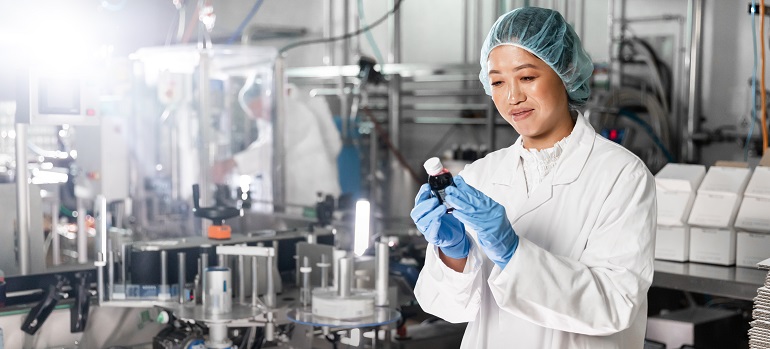Manufacturing, engineering, logistics & transport
Tāmaki Makaurau has had the country’s largest manufacturing base for many years.
On this page
It represents almost 83,000 workers in the region, being almost 9% of all the filled jobs in Tāmaki Makaurau and 34% of the national manufacturing sector workforce.
Although the region has lost much manufacturing (such as motor assembly and home appliance manufacturing) during the 1980’s period of tariff elimination, Tāmaki Makaurau continues to provide manufacturing jobs as diverse as food, construction materials, metal and plastics, health products and aerospace. The Manufacturing sector continues to rapidly expand in Tāmaki Makaurau, accounting for 9% of regional GDP ($10.8 million), and 4% of the national businesses in Aotearoa New Zealand. It is the second-largest employer of Māori, the most significant employer of Pasifika and an essential contributor to regional employment and growth regionally and nationally .
Regional Skills Outlook(external link) — Infometrics
Hanga-Aro-Rau
Hanga-Aro-Rau Workforce Development Council represents industries such as Manufacturing, Processing, Extractives and Drilling, Transport, Postal and Warehousing. The manufacturing workforce is linked to Hanga-Aro-Rau (Manufacturing, Engineering and Logistics). In 2021, Hanga-Aro-Rau Workforce Development Council industries had 203,687 filled jobs with a contribution of $25,892 million to GDP. The highest occurring occupation was sales representatives, constituting 3.4%. There were 9.6% Māori employees (Infometrics 2022).
Hanga-Aro-Rau has recognised the importance of Tāmaki Makaurau in its coverage area and is developing a major presence in the region. The RSLG Group will work closely with Hanga-Aro-Rau to ensure the development of vocational training and skill programmes that will address the skill and labour shortages in the Manufacturing, Engineering, Logistics and Transport sectors in Tāmaki Makaurau. In addition to the Workforce Development Council, the Government has established Industry Transformation Plans, especially in Advanced Manufacturing, which will inform labour market policy in Tāmaki Makaurau.
The Manufacturing sector provides a diverse range of jobs from process workers, apprentices and tradespeople to highly qualified degree holders working in advanced manufacturing roles. The sector has roles with higher qualifications (degrees 23%), but also a large portion of those with no qualifications (15%) and Level 1 and 2 certificates (18%), highlighting the need for upskilling for improved productivity. There is also an urgent need to upskill the workforce with digital and ICT skills, numeracy and literacy to improve overall workforce productivity and prosperity. This also includes working with the Advanced Manufacturing Industry Transformation Plans to build the sector's capability and competitive advantage.
There was major dislocation for many manufacturing workers during the period of the late 1980s and 1990s, and while job opportunities have now grown, multi-generational unemployment exists within a disproportionate number of Māori whānau within South and West Auckland. Workers have been forced to move from better paying and secure manufacturing jobs to lower paid and more casualised service sector jobs. This needs to be addressed with appropriate interventions. The region's future focus on Manufacturing and its importance for the Pacific Peoples' workforce in Tāmaki Makaurau has been identified as an area where the RSLG and Workforce Development Council agree to collaborate.
“We collectively have an exciting opportunity to work together to help realise the potential of such an important part of our workforce. Hanga-Aro-Rau is undertaking a TEC COVID-19 Relief Fund research project during 2022, "Post COVID-19 Workforce Development Needs in New Zealand's Manufacturing and Engineering Industries", which focuses on Tāmaki Makaurau and Canterbury employers. This research will provide an evidence base for further collaboration and actions to inform workforce strategies that address the identified gaps and barriers to skills development.”
Hanga-Aro-Rau Chief Executive Phil Alexander-Crawford

Photo: Auckland Unlimited
As a transport and logistics hub, Tāmaki Makaurau provides a huge range of transport, warehousing and other logistic jobs. It represents almost 43,000 workers in the region comprising of transport, postal and warehousing: 4.6% of all filled jobs in Tāmaki Makaurau and 41% of the national manufacturing sector workforce. Many large companies, including large retail brands, have their Northern or Aotearoa New Zealand distribution centres in Tāmaki Makaurau. The airport precinct, inland ports and other designate hubs provide a large amount of warehousing and logistics space. There has been a boom in small parcel delivery through the city as a response to COVID-19 and many senior high school students in South Auckland have been attracted to work in courier distribution centres rather than complete studies in 2021 or begin tertiary study in 2022. Along with warehousing, road and rail freight transport provides many jobs in Tāmaki Makaurau. There have been chronic skill shortages for road transport drivers (especially Class 5) for many years and through the COVID-19 period this has now reached acute levels.
Regional Skills Outlook(external link) — Infometrics
Driver shortage: food hit?(external link) — NZ Herald
Public passenger transport is also a large employer in Tāmaki Makaurau with drivers and other staff employed throughout the bus, train and ferry networks of Auckland Transport. This industry has been dogged by low wages over the years which has resulted in staff shortages. New arrangements are being made between Government, Auckland Transport, bus companies and unions to make the living wage the minimum starting rate for bus drivers, and this should attract more workers into the industry. The logistics hubs and inland ports around the airport and South Auckland ensure local and imported goods are distributed within the region’s large population and throughout the country.
Manufacturing sector labour market and workforce insights
- A high-value sector contributing to 8% of Tāmaki Makaurau’s GDP. Tāmaki Makaurau is home to the largest workforce in the country (34%).
- The sector has both highly skilled roles (29%) but also has a large portion of low skilled roles (almost 40%), highlighting the need for upskilling for improved productivity.
- Currently, there are more than 82,000 filled jobs in Manufacturing in Tāmaki Makaurau, and this is forecast to increase year on year.
- The sector is forecast to grow both replacement and new jobs between now and 2027. There are 27,451 total job openings in this sector from 2022-to 2027, consisting of 4,278 new jobs being and 23,173 net replacement job openings. This is set to grow year on year.
- The sector currently employs 34% females, compared to 47% across the Tāmaki Makaurau region.
- The sector also employs 8% of Māori workers and 18% of Pacific workers.
- Labour market gaps present the potential for clustering for productivity gains given the region’s size and scale.
- Acute workforce shortages across the sector are slowing the impact of a booming Manufacturing sector with much demand on the books, and this is rising. The BNZ-Business New Zealand Performance Manufacturing Index (PMI) for July 2021 increased to 62.6; the second-highest recorded and 1.7 above the June 2021 index. However, the recently announced border exceptions for Manufacturing sector workers will hopefully ease workforce pressure.
Regional Skills Outlook(external link) — Infometrics
Performance of Manufacturing Index(external link) — BusinessNZ
Labour shortages for manufacturing sector(external link) — RNZ.co.nz
Beehive workforce pressures for manufacturing eased(external link) — Beehive.govt.nz
Manufacturing sector actions
- The RSLG supports skills development for Manufacturing sector workers. This includes support to Hanga-Aro-Rau WDC with its TEC COVID-19 Relief Fund research project, and support of upskilling initiatives such as Project Ikuna. This provides the Pacific workforce with support for literacy and numeracy skills to allow students to succeed in the upcoming digitally enabled manufacturing workforce.
- The RSLG promotes skilled Māori workforce in the sector. There is an opportunity for the Manufacturing sector to grow its presence in Tāmaki Makaurau with Tāmaki 10,000 engaging Māori communities, whānau, hapū and iwi to become more proactively involved in the sector, both as employees and employers.
- The RSLG supports growing productive and customer-focused manufacturing firms and to collaborate with the Employer and Manufacturers Association and Hanga-Aro-Rau WDC in developing manufacturing workers' skills and worker readiness initiatives.
Employee Manufacturers Association website(external link)
Ohu Mahi - Workforce Development Councils(external link)
Project Ikuna - Upskill your Pacific workforce(external link) — AucklandNZ.com
82,000 filled jobs in manufacturing
27,451 new jobs in the next 5 years

Photo: Auckland Unlimited

